This is how Korean moms make Gochujang at home every year in spring. This is a very authentic and traditional way to make Korean chili paste! If you have the ingredients and some time, this somewhat long process is totally worth it!
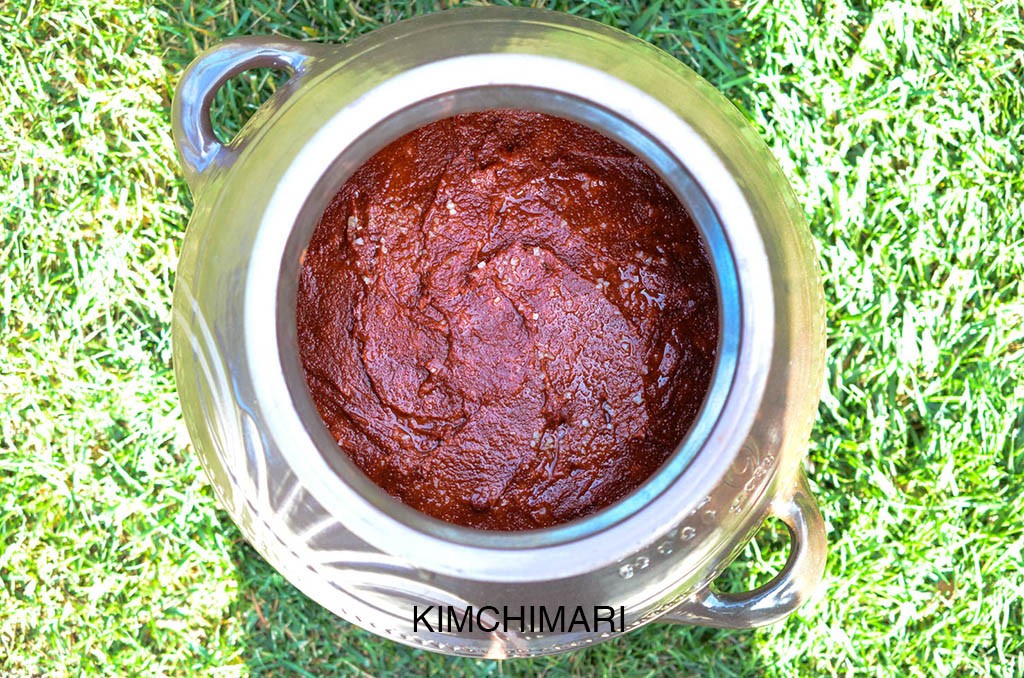
What is Gochujang?
Gochujang is a Fermented chili paste and NOT a sauce.
Yes, Gochujang is NOT a sauce ladies and gentlemen. The one you add on Bibimbap IS a gochujang sauce because the Gochujang paste is mixed with vinegar, sugar, water and any additional seasoning to make a sweet gochujang sauce.
An authentic fully fermented Korean Gochujang is made from fermented soybean powder (meju garu 메주가루), korean red chili powder (gochugaru 고추가루), sea salt, rice syrup (jocheong 조청), malted barley powder (yeotgireum garu 엿기름가루) and sweet rice flour. Additional ingredients like maesil cheong syrup, rice flour, barley can be added to make different variations.
Gochujang is a fermented red chili paste that Koreans love to add to sauces, marinades, stews, soups.. just about on everything. Make a sweet & sour gochujang sauce by mixing vinegar, water, sugar or syrup then use this on your bibimbap or just toss any fresh or steamed vegetables.
Most popular Korean dishes that use Gochujang is Tteokbokki and Spicy Pork or Chicken Bulgogi. I also have a Gochujang Oven Baked Chicken that’s my simplified version of the original.
WHAT DOES GOCHUJANG TASTE LIKE?
The gochujang paste itself is spicy, salty and slightly smoky and funky with just a hint of sweet flavor. Chances are, you probably have never tasted the full glorious flavor of the raw gochujang paste itself but rather sauces with gochuang in it.
The gochujang tubs you buy from the grocery store is much sweeter than my home fermented gochujang because the manufacturers add corn syrup to it. In fact, if you look at the ingredient list, sadly, corn syrup or starch syrup is usually the first ingredient which means that is the major ingredient.
GOCHUJANG VS SIRACHA
How is Gochujang and Siracha different?
Siracha and Gochujang are both spicy but Siracha is a mix of red chili, garlic, sugar, vinegar while Gochujang is a 6 month fermented chili paste. So while Siracha is fresher and tangy tasting as you can imagine Gochujang is a lot more complex and has deeper flavors full of umami + mild funky flavor.
In addition to spicy flavors, Gochujang is salty while Siracha is not. So be aware that when you add Gochujang, you are not just adding spicy flavors but also saltiness.
Is Gochujang hotter than Siracha?
Well.. that’s not very simple to answer because Gochujang comes in different spicy levels from mild to extremely very hot! Siracha is made with Siracha peppers and depending on the crop, it is said to have anywhere from 1000-1500 SHU (scoville heat units) on the Scoville scale.
Recently, CJ announced that their Haechandeul 해찬들 Gochujang will be made in 5 different levels of spiciness with the range of SHU numbers: mild 순한맛 (300-600), slightly hot 약간 매운맛 (600-900) , medium hot 보통 매운맛 (900-1500), very hot 매운맛 (1500-2000), extra hot 아주 매운맛 (2000 and above). So just from this, one can say that Siracha would be comparable to medium hot Gochujang but maybe more spicy or less spicy than some.
How Spicy is Gochujang?
Well, as you can see from above, Gochujang spicy level can range from mild to very hot with their SHU levels going from 300 all the way to 2000 and plus. But the average one is around 900-1500 SHU which is quite mild in the scale of chili peppers. In my personal opinion, much like anything, if you add a lot of it, it will be spicy while if you add just a little bit of Gochujang, it will add great complex flavor while not making it too spicy.
If you asked me 5 years ago, whether I make my own Gochujang, my response would have been something like – “No…..I don’t do that…that’s too much work.. oh, only our mothers did that.”
But here we are, in my 6th year of blogging; I have already attended two Gochujang making classes (in Korea last February) so that I could make it at home this year. During my recent stay in Korea, I got to taste some great homemade gochujang and deonjang and I realized store bought gochujang and homemade gochujang is just not the same. In addition, I have also discovered that not all gochujang sold at stores are the same.
WHICH GOCHUJANG SHOULD I BUY?
Did you know that often a not-so-good gochujang has corn syrup, starch syrup and even hydrolyzed vegetable protein as part of their ingredients??? A good quality gochujang should have minimum ingredients – only have chili pepper powder (gochukaru), fermented soy bean powder (mejukaru), sweet rice/rice/brown rice/barley/wheat flour, rice syrup, malt barley syrup or powder and salt.
And even if it has corn syrup, at least don’t buy one that has corn syrup as it’s first ingredient. I mean..imagine.. how much corn syrup that is!! Sometimes some alcohol is added to stop the fermentation process but that’s it. So please read the gochujang ingredients carefully.
In Korea, there are many great quality gochujang in the market but sadly almost none of them are sold in the US… or outside of Korea.
The Ingredients needed to make Gochujang
FINE KOREAN RED CHILI POWDER (고운 고추가루 GOEUN GOCHUKARU)
Gochugaru or Korean red chili powder is the most important ingredient for this wonderful hot pepper paste. As you probably know, each chili has a different level of spiciness but also a different flavor profile. Korean red chilis have the perfect balance of spicy and sweet flavor to really make the best gochujang so please do try to use a Korean one.
We use both COARSE and FINE gochugaru in Korean cooking. Below you can see the 2 different kinds. FYI, the left one is darker in color because they are last year’s crop. Gochugaru becomes darker in color when they are over 1 year old. The fresh crop Gochugaru has brighter and more orangish red color.
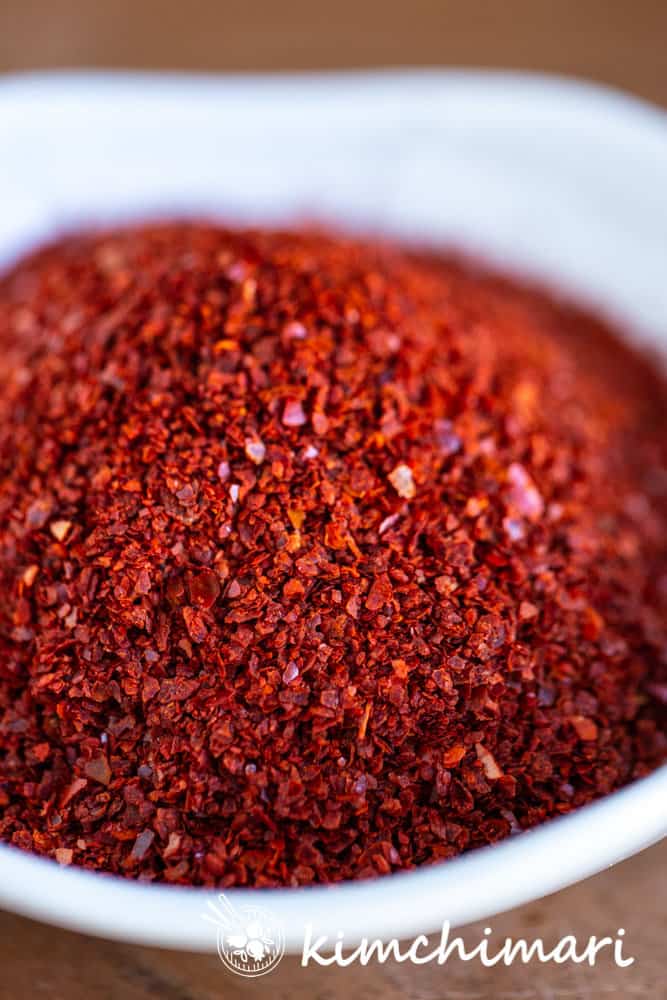
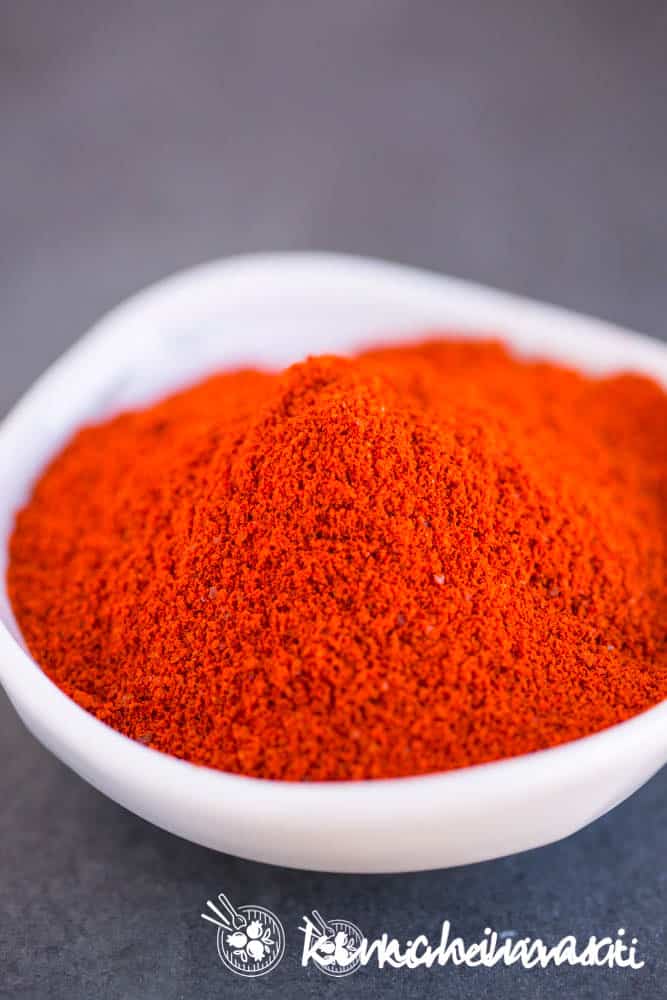
Coarse Korean red chili powder (Gulkeun Gochugaru 굵은 고추가루) is what is used the most in Korean cooking these days and over 90% of Gochugaru sold at markets is probably coarse. Traditionally coarse red chili powder was used in making all kinds of Kimchi except for water Kimchi (mul kimchi 물김치). Coarse gochugaru gives you brighter red color and has a cleaner flavor with even a bit of a zing. It is also used to make jjigae, guk and namul.
Fine Korean red chili powder (Goun Gochugaru 고운 고추가루) is definitely needed in making gochujang and then for mul kimchi. Look for bags that say “고추장용” which means it’s for making Gochujang. Also used to make refined sauces and sometimes used for making more elegant moosaengche. Fine gochugaru produces less clean almost kind of a muddy taste and thus not usually used for fresh vegetables but can be used for stews and soups.
If you want to make a hotter gochujang, try substituting a part of the chili powder with some red Cheongyang chili pepper powder.
MEJU POWDER (메주가루 FERMENTED SOYBEAN POWDER)
Meju is a block of cooked soybeans that are fermented with salt and water to make soy sauce and Korean soybean paste (Doenjang). Meju powder is the crushed and powdered form of the soybean blocks. So the meju powder is the ingredient that gives real authentic gochujang its funkiness.
FYI, Japanese miso is very similar to Deonjang and so I know there are recipes out there that use miso paste as the base for making Gochujang. Please know that miso paste is NOT used in traditional Korean Gochujang recipe. It’s just a quick way to make something similar. It will totally miss the funky complex awesomeness a properly fermented gochujang will have.
You can READ MORE about Deonjang in my Know your Doenjang post.
YEOTGIREUM GARU (엿기름가루 MALTED BARLEY POWDER)
The role of the Yeotgireum Garu is to break down the starch of the sweet rice flour (or other flours like barley or wheat if used) into simple sugars with its enzymatic activity. Once the starches are broken down the various bacteria from the meju powder and air will ferment the gochujang over 6 months.
My favorite to use is the Korean malted barley powder that’s still coarse enough for you to see the barley husks. If you need to buy a substitute for Yeotgireum Garu, then try to buy diastatic malt barley powder where the enzymes can be reactivated once hydrated.
KOREAN SEA SALT (천일염 CHEONILYEOM)
You may think salt is a salt.. no..
Did you know that different salts based on where they are sourced (land vs sea), how they are produced (boiling, drying in sun etc) the salinity per volume is different and also the flavor profile is different.
Korean sea salt have a more earthy and slightly bitter taste than other salts while having lower sodium than most. So if you used a non-Korean salt, you will need to adjust the amount based on the different amount of salt. To see how different salts can be, you can read my Best Salt for Kimchi post where I compare 12 different salts. Also, just because it’s Korean salt, doesn’t mean they are the same so be sure to use the Coarse Solar Sea Salt (Cheonilyeom).
RICE SYRUP (조청 JOCHEONG)
Korean Rice Syrup is made by first breaking down cooked rice with malted barley powder soaked in water. The resulting liquid is similar to Sikhye and then this is boiled until it is reduced to syrup consistency. Commerical gochujangs add corn syrup instead of Jocheong because that’s less expensive but traditionally this syrup is added to add sweetness.
Equipment needed for Gochujang Making
- 1 5 quart or larger Korean gochujang hangari (항아리)/onggi (옹기) = glazed clay vessel or pot that can hold liquid but is porous for it to breathe
- 2 large bowls (5 quart or bigger)
- fine sieve or medium grade (#50) cheese cloth
- 1 large pot (5 quart or larger)
- 1 fine mosquito net or fine mesh fabric to cover top of gochujang pot
- 1 string to tie mesh fabric
- coals, sesame seeds, metal bowl (optional)
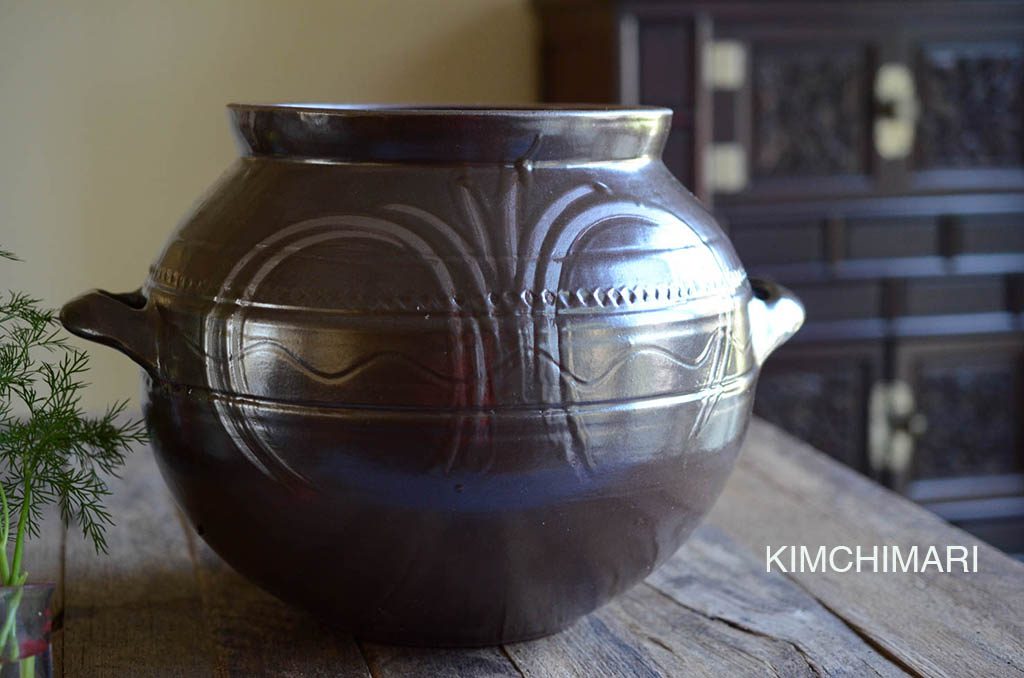
Traditionally, Koreans make Gochujang only at certain times of the year!
Gochujang is typically made in the colder winter months between the end of November to February in Korea. It is because the 4~6 month fermentation needs to occur in FULL SUN but BEFORE the very hot and rainy summer starts in Korea.
For California, I thought February would be a great time since by then hopefully rain is getting lighter and there are more sunny days. So when I was getting ready to move back to the US in 2014, I bought and shipped Korean gochukaru (고추가루 red chili powder), mejukaru (메주가루 fermented soybean powder) and cheonilyeom (천일염 solar sea salt) via sea with our moving stuff so I could make it in CA.
And most importantly, I also purchased a Korean hangari/onggi vessel where I could ferment the gochujang in. This particular vessel was made by one of the few remaining Korean artisans who is deemed by the government to be part of Korean’s national heritage.
GLUTEN-FREE GOCHUJANG WITHOUT MALT BARLEY POWDER
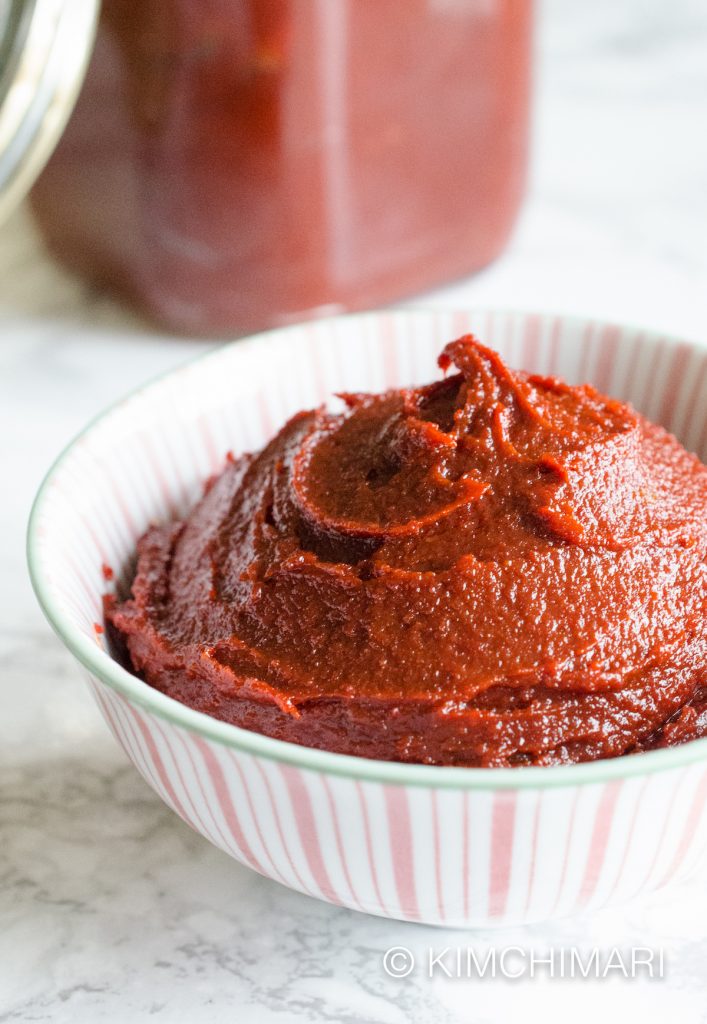
If you need to be gluten-free and don’t want to use the malt barley (Yeotgireum Garu) or if you can’t buy malt barley powder, you may want to use my Easy Homemade Gochujang Recipe which doesn’t use malt barley but just rice syrup (Jocheong 조청).
WHERE CAN I BUY INGREDIENTS ONLINE?
You can buy all the ingredients from my store HERE. And look under the Gochujang Ingredients list.
Traditional Homemade Gochujang Recipe
Makes: 4 quarts Prep Time: 6 hrs Cook Time: 6 hrs Difficulty: Medium
Ingredients
See Recipe Card below for scalable ingredients —
Step-by-Step Instructions on How to make Gochujang at home
- 1-2 DAYS BEFORE: Sterilize your ghochujang hangari or onggi (Korean glazed clay vessels aka earthenware for fermentation) by pouring hot boiling water inside and out and drying them. OR you can use coals that have turned into white embers by putting them in a metal bowl and turning over the hangari on top so that the hangari gets filled with HOT smoke which will also sterilize the pot. I used both methods just to be sure. Here is a picture of how it was done:
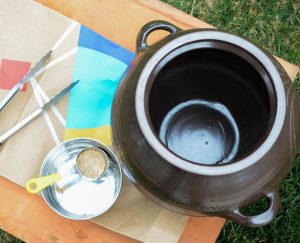
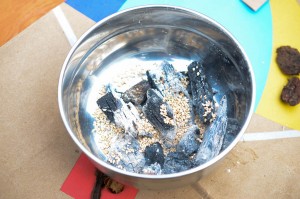
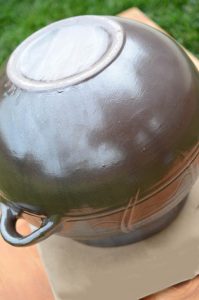
The hangari will smell very smoky at first, but it will go away as you air it for a day or two. It is also the intention to have a little bit of sesame seed smoky flavor. If you don’t want this, just use hot water.
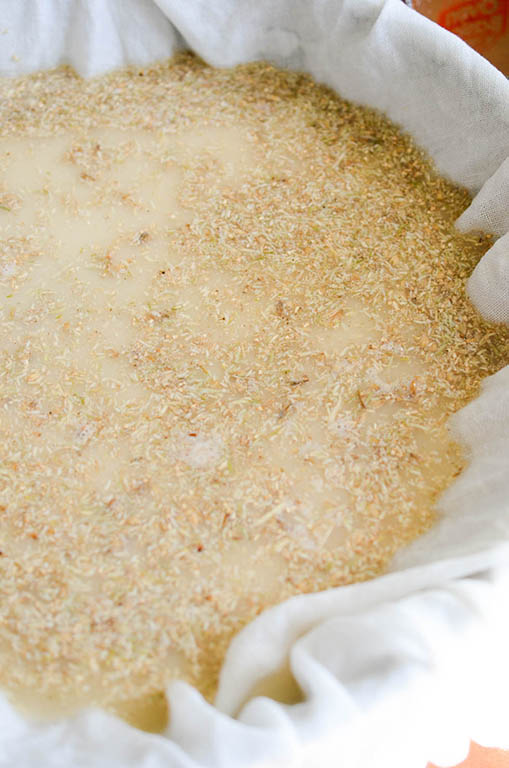
Malt barley (yeotkireum) in cheesecloth
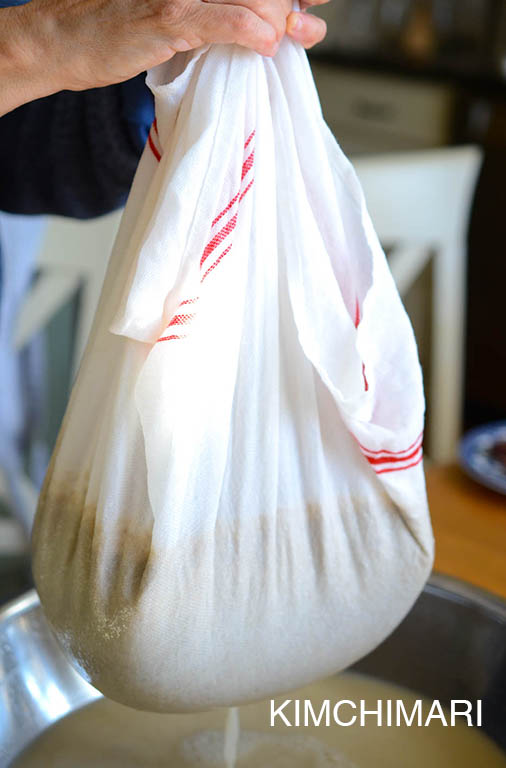
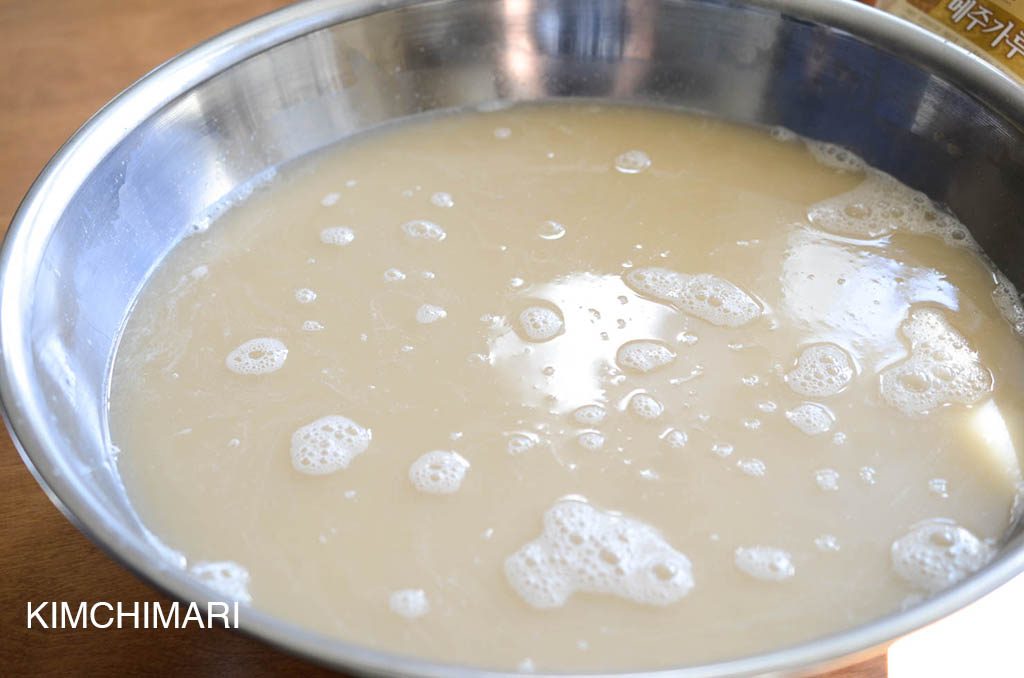
Malt Barley liquid strained using cheesecloth
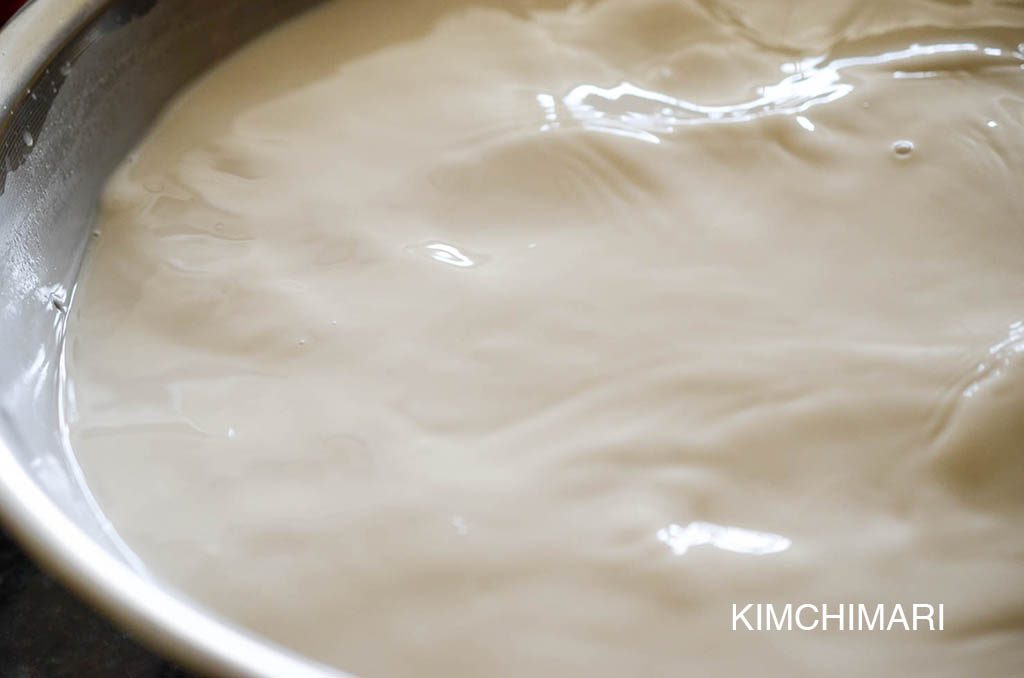
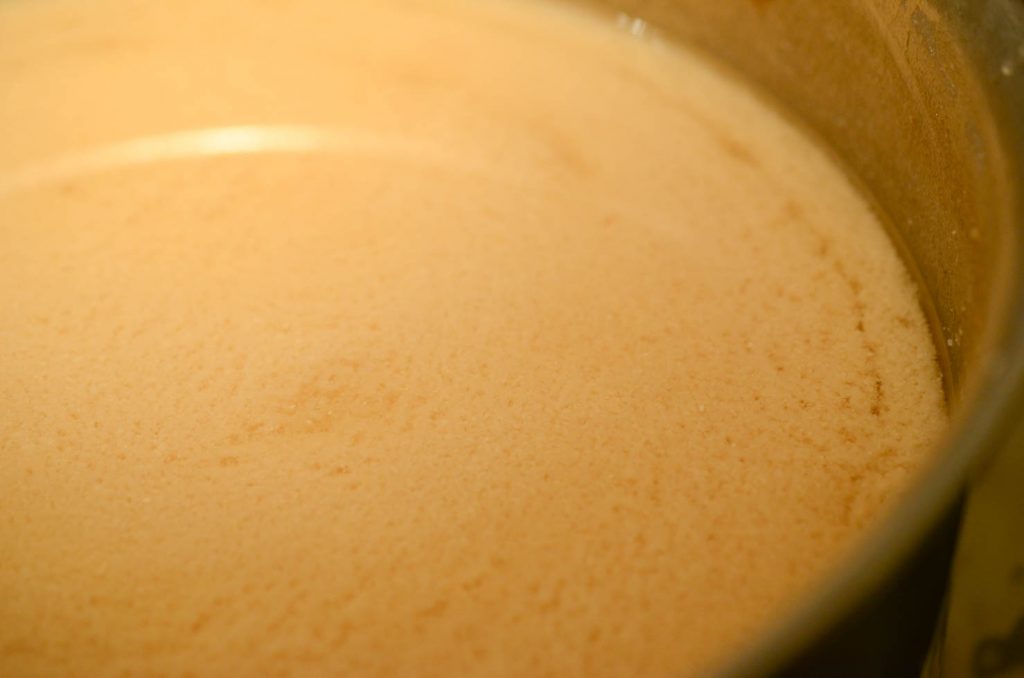
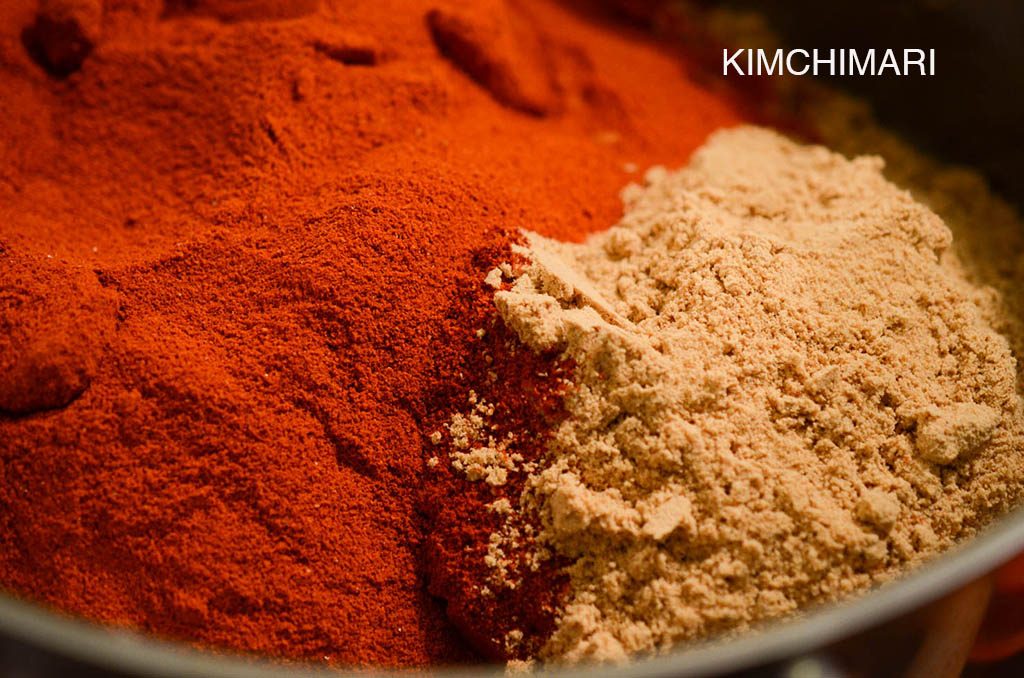
It made me happy just looking at them, smelling the beautiful and familiar smells – the spicy gochukaru tickling my nose and then the very endearingly stinky deonjang smell from the mejukaru taking me back to my childhood..to the days when moms made everything at home.

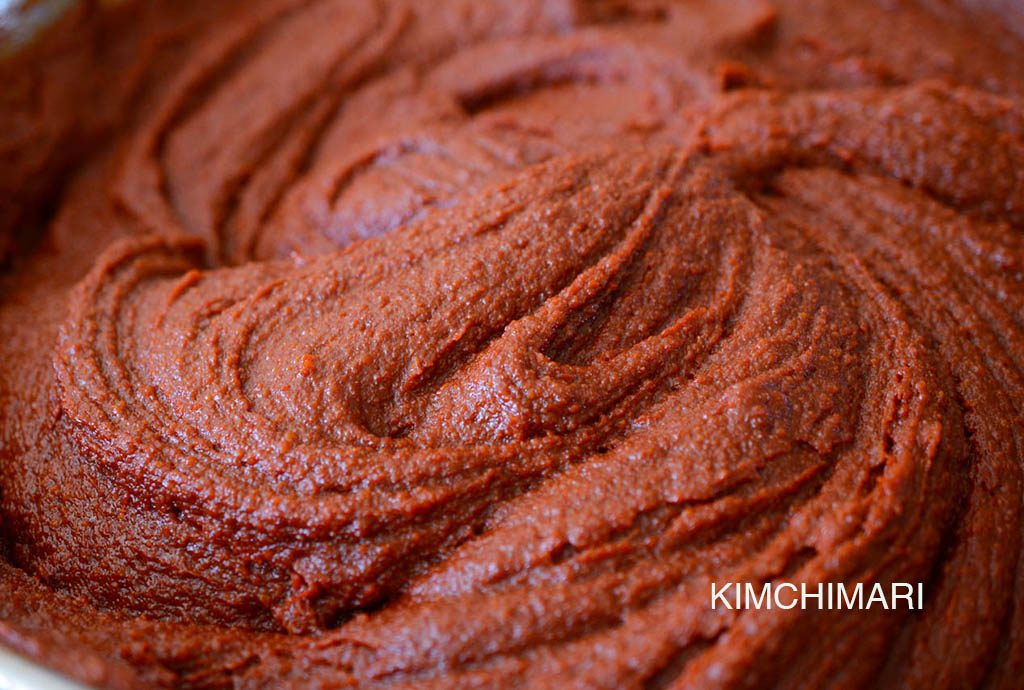
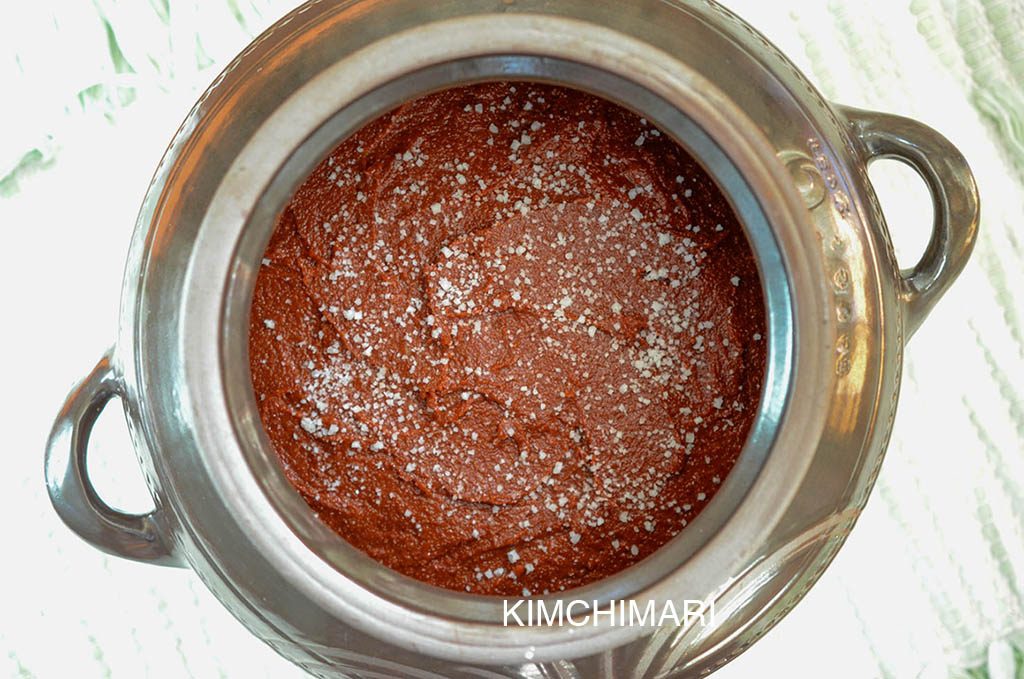
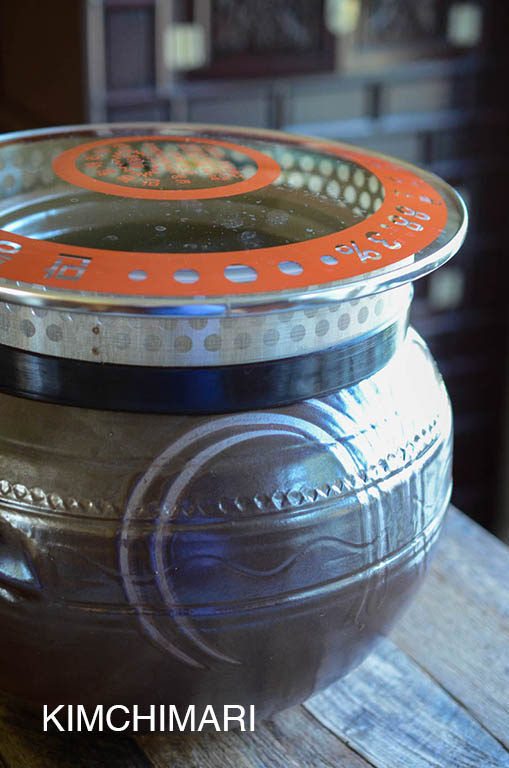
And I hope to share with you how my gochujang turns out under the California sun in the next 6 months.

The salt crystals are like little diamonds~~ love love love..♥♥♥
Well, I know this is probably not something you can make easily and you need various special ingredients and vessels but I thought I would share it with you so that at least you get to experience and know what is involved in making the amazing gochujang the traditional and authentic way.
- You can also buy Korean Traditional Earthenware for fermentation on Amazon.com. The size is not very big so you may need more than one but it should work. I have selected a few below.
- If you REALLY want to buy the Korean Hangari/Onggi in the US, try visiting a larger Korean grocery market.
- A HUGE THANK YOU to my friend Judith for asking me to post a Gochujang recipe and then also coming to my house to help me make this wonderful paste.
Here’s my new Video on how to make Gochujang at home!
XOXO
JinJoo ❤️
How to make Gochujang at home
Ingredients
- 1.5 kg Fine Red Chili powder (Goun Gochukaru 고운 고추가루) (1.5kg = 3.3 lb)
- 500 g Fermented Soy Bean powder (Meju Karu 메주가루) (500g = 1.1 lb)
- 1 kg Sweet Rice (made into powder – Chapssal Karu 찹쌀가루) (1 kg = 2.2 lb)
- 750 g Milled Malt Barley (Yeotkireum Karu 엿기름가루) (750g = 1.65 lb)
- 750 g Sea Salt with bittern removed (Cheonilyeom 천일염) (750g = 1.65 lb)
- 1 kg Rice Syrup (Jocheong 조청) (1 kg = 2.2 lb)
- 5 liter cold water (5 litre = 5.2 quart)
Instructions
- THE NIGHT BEFORE: Soak 750 g Milled Malt Barley (Yeotkireum Karu 엿기름가루) in 5 liter cold water for 5 hrs or more.
- THE NIGHT BEFORE: Soak whole 1 kg Sweet Rice (made into powder – Chapssal Karu 찹쌀가루) in water for 3-4 hrs or more.
- NEXT MORNING: Strain soaked sweet rice through a colander and remove all excess water.
- Grind sweet rice with a blender or chopper as fine as you can make it. Set aside.
- Strain malt barley through a fine sieve or medium grade cheese cloth to just get the liquid and some fine white sediments. Discard the malt barley.
- Add sweet rice powder to strained liquid from above.
- Leave mixture in the oven with a temperature of about 60°C (140°F) for 5 hrs.
- Remove malt barley + sweet rice mixture from oven and cook on stove top.
- Start at medium high -> medium heat until liquid has reduced by about 20%. Let it cool.
- Once liquid is cooled, add 1.5 kg Fine Red Chili powder (Goun Gochukaru 고운 고추가루), 500 g Fermented Soy Bean powder (Meju Karu 메주가루) and 750 g Sea Salt with bittern removed (Cheonilyeom 천일염).
- Add 1 kg Rice Syrup (Jocheong 조청) – add more or less to your taste.
- Mix everything well.
- Transfer gochujang into the prepared, sanitized clay pot (hangari 항아리).
- Sprinkle top with handful of sea salt.
- Leave in full sun for 6 months.
Tips & Notes:
Please check out my blog post for more details on how to sterilize the pot 1-2 days before.
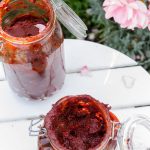
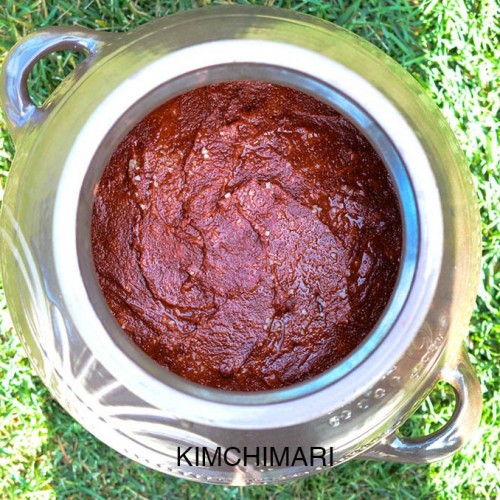
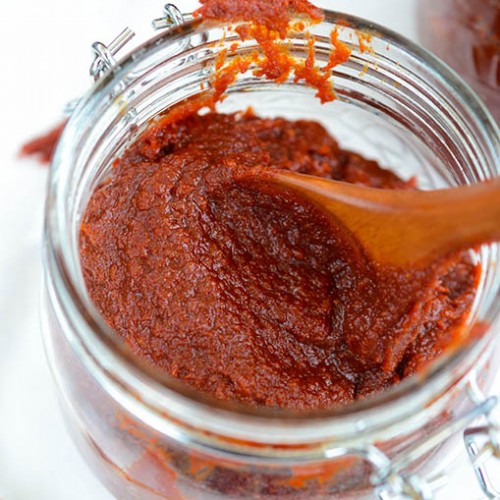
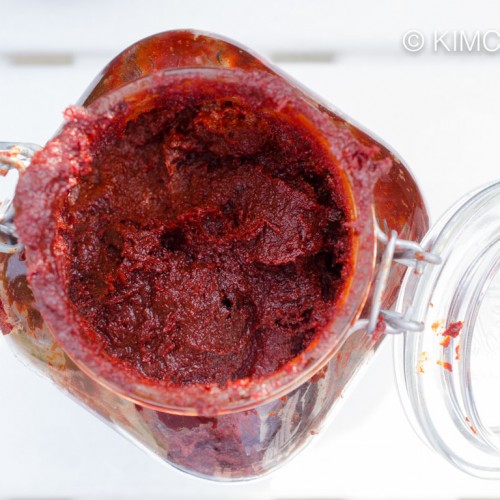
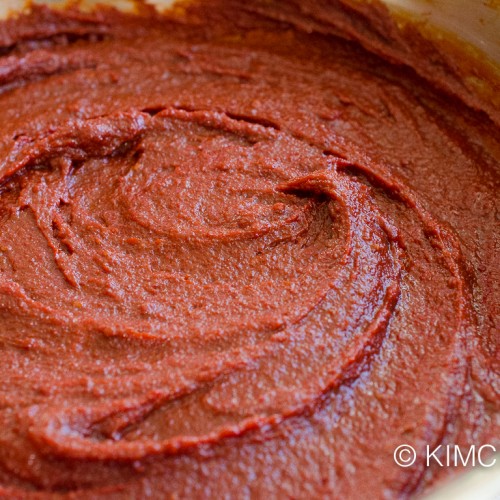
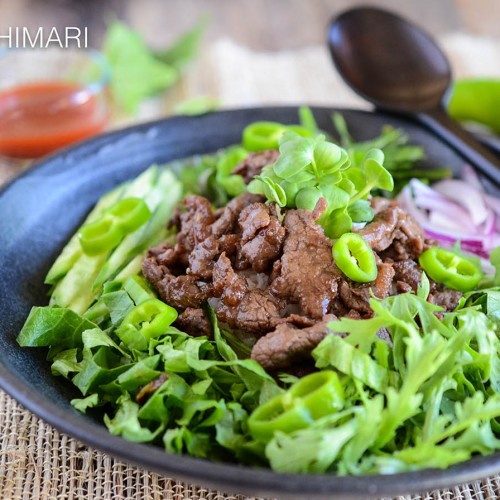
















Hi,
After you sprinkle the salt on top just when it is finished, do you set for a week then stir, cover with salt again and repeat incrementaly every week? Won’t that make it very salty in the end?
Hi! No you won’t be adding salt every week. Only in the beginning and if you see any signs of white or yellow fungus forming. And you can let it ferment in the fridge without worrying about fungus – if weather is warm for you where you are. Hope this helps.
Hi JinJoo!
I have seen over the internet some quick home-made gochujang recipes.
They consists in the following ingredients:
-Water: 270 ml
-Brown sugar: 250 g
-Miso: 300 g
-Korean Chili pepper powder: 100 g
-Salt: 1 tablespoon
-Japanese sake or Korean soju: 1 teaspoon
-Rice vinegar: 1 teaspoon
How to prepare:
-Pour water in a large enough pan. Add sugar. Heat until all brown sugar is dissolved.
-Add miso. Keep heating, stirring with a wooden spatula all the time until mixture is smooth.
-Once most of the water has disappeared, add Korean Chili pepper powder. Mix well. Keep heating and slowly stirring untl water has disappeared and big bubbles start bursting at the surface.
-Switch off fire. Let cool until about 25~30 degrees Celsius temperature. Add salt, sake/soju and rice vinegar. Stir well. This last step at this temperature will insure that all yeasts are killed and will prevent further fermentation.
-Secure inside a vessel and leave inside the fridge. Can be kept for a whole year inside the fridge.
My question: Do you personally think that this recipe approaches the real chunjang? Do you think it is valid to prepare it for those who do not want to wait several months?
Thank you very much!
Johnny
So I have not tried this recipe myself but from the looks of it, it looks like it will produce a gochujang that is similar to the ones you buy from stores. But at least it doesn’t have corn syrup in it.:) I think it is totally valid to prepare this faster gochujang recipe since the commercially available ones are almost always this kind. Having said that, the ones that takes months to ferment (i.e. my gochujang recipe haha) have a totally different flavor profile. Basically it has the deep, complex flavor that only comes from real active fermentation and the umami taste just gets better over months. I am also planning to post a ‘instant’ gochujang recipe that you can make in just few minutes so stay tuned! Thanks for taking the time to ask! All the best.
Thank you for taking the time to reply! Always so friendly!
Yes, I understand that your recipe, that is fermented over months, is very rich in umami and I want to try it as soon as I reach all the ingredients!
Sometimes I want to prepare for example, a plate of tteobokki or bibimbap, and I don’t have gochujang, neither it is avaiable to be bought in my city……. this is the reason I would like to try this quick recipe, but I was afraid that I might loose in flavour significantly. But as you think it is totally valid to prepare it, now I’m more relaxed! hahaha
I am looking forward for your instant gochujang post!
Do you know if there is a recommended temperature range during the fermentation process? You mention starting this during the cold winter months, but I’m wondering if this would work in Hawaii . . . maybe on a sunny windowsill inside rather than outside to keep a more moderate temperature than if outside? Or am I off track and warmer would be better?
Korean weather is relatively cold to warm during months of Feb – Apr. Temperatures above 80 F is probably starting to get too warm for the start of the fermentation process. But once it is fully fermented (after 3 months or so) then it can stand warmer temperatures. Also exposing it to Sun is important because without it, it can start to develop molds. Generally a mild temperatures is best for slow fermentation. So, yes, having it on a sunny windowsill will work but you will have to endure the smell.. 🙂 About 1-2 months after it has fermented, you can cover it and keep in fridge. It will ferment in there too. Hope this helps!
Hi Jinjoo, in Korea where they ferment gochujang for years inonggi, where and how do the store the gochujang in summer? Everything I read online, only gives me information up to 6 months fermentation (winter & spring), but after that, no information. So I’m really curious about that. It would be more awesome to be able to age this gochujang for years.
Hi Serena, so normally gochujang is made every year which also means they are only supposed to last a year. Most of the time, gochujang that is over a year old is not used for cooking but just for making jangahjji (pickles). There are of course certain areas in Korea like Sunchang (which is famous for their gochujang) where you can find gochujang that has been aged for even 5 years. But to do this, you do need to be able to take good care of the gochujang and also I think it must be made in huge amounts. Because it can actually go bad or become too dry. People do store gochujang in onggi in the summer but it should not get rained on and it should be turned so it doesn’t dry too much. Also you may have to sprinkle some extra salt if you see too many white fungi on top. You could also keep it in your fridge during the summer in which case you don’t really have to care for it that much. I have been keeping my gochujang in the fridge since spring and I am finding that it is developing even a deeper flavor by now and I have a feeling it will stay good well into next year. Hope that helps and thanks so much for asking!
That is so interesting. Well at the very least you’ve convinced to make a smaller batch and not to age it outside past spring. After all we’re not exactly jang masters who can tend to it everyday, are we? Hahaha……
Hi Jinjoo, i just finished making my Homemade Gochujang 2 days ago i use only Yeotgireumgaru, Gochugaru (Fine Powder), Sweet Rice Flour, Ssalyeot & Kosher Salt but WITHOUT Mejugaru. Today i tried to taste my gochujang and i found it a lil bit too salty. Should i be worry? Should i add more ssalyeot into the jar? Thank you Jinjoo^^
Hi! Gochujang will be a bit salty when you taste it alone but should not be so terribly salty. I’m not sure how it works without the Mejugaru but you can certainly add more ssalyeot if you think it’s way too salty. I would love to hear how it turns out without Mejugaru so please keep me updated. Thanks for asking and good luck!
Hi. I want do Gochujang myself since one year ago. But i don’t find Mejugaru anywhere (all Korean grocery don’t have Mejugaru)). On the internet when i find it, isn’t possible to purchases for my country (France, Paris). How do mejugaru myself or How to substitute it with something else! Sorry for my approximate english. thanks you
HI Lamia, That’s too bad that you can’t buy mejugaru…sorry to hear that. So, you can make mejugaru yourself by making meju from cooked soybeans but that takes a lot of work, time and also smells pretty bad. I do plan to post about that one of these days. But I did see a recipe for making gochujang from deonjang. So basically you add some vegetable broth (kelp, onion) to deonjang and then add find red chili powder, korean sea salt, rice syrup (jocheong). I don’t have the exact recipe yet and have not tried it myself but I will try to test it and post a quick recipe soon. Hope it helps. Thanks for asking!
Thank you very much for responding so quickly. Too bad I should be satisfied with the sauce sold in store.
I’m very excited to hear how this turns out. I’m trying to make gochuchang for a friend who is sensitive to wheat and soy. I’ve been trying to figure out a good replacement for meju. I had the idea of using a different malted grain, but I will have to try the rice syrup! Let me know how it turns out.
Hi Benjamin,
Thank you so much for your comment. Have you found a replacement for meju? I am kind of finding that hard because that’s the building block of gochujang and doenjang. Let me know how it turns out for you. thanks
Where can I get a larger pot from do make this? Looks very good
I bought mine in Korea but you should be able to buy it from some larger Korean grocery stores. I also have one online under Fermentation category in my SHOP but I just checked and they seem to be out of stock. I also do talk about one artisan that makes these onggi pots but not sure if you want to go to that much trouble. You could probably make the gochujang using other vessels as long as you leave the top open to breath. Let me know if you have more questions! Thanks for asking.